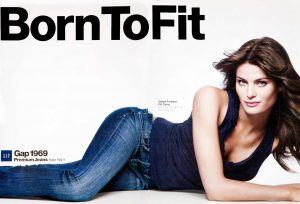
This ad by Gap, with the slogan “Born to Fit”, is promoting one of the company’s most common products: women’s jeans. However, this ad promotes much more than just this single item. In fact, this promotional photo focuses less on the jeans and more on the beautiful model – white, skinny, and suggestively curvy – lying seductively in the foreground. Even to endorse such an ordinary, boring piece of clothing, this ad aims to imprint an image of the perfect, sexy female on the impressionable minds of women (especially young girls) pining to be as gorgeous as the model in the advertisement. “Born to Fit” suggests that YOU the consumer, were made to be wearing these highly desirable and attractive jeans, and that these jeans were made uniquely for you to look and feel sexy. YOU were made to catch every eye in every room! YOU were designed for these jeans, and they were designed for you! These jeans will turn you into the sexy, unique woman you were born to be, and only Gap jeans will do this for you.
In reality, no pair of jeans will make or break a woman. No piece of clothing will imbue a woman with her uniqueness, her personality, or her sexiness. All of these traits must come from the woman herself. However, to young and impressionable minds, a picture is worth a thousand words. Gap knows this, and aims to implant the need for Gap jeans (and all the benefits they supposedly bring) into the minds of enchanted consumers who will provide an endless source of revenue.
Contrary to what Gap tells its consumers, no one’s goal in life should be to wear a specific piece of clothing, or aspire to a large corporation’s body image ideals. This is what my culture aims to address.

Here, my culture jammed version of Gap’s “Born to Fit” advertisement reveals the weakness in the premise of this promotion. I’ve changed the slogan to become: “Born to Fit (In)”, which shows that buying into Gap’s product is not a commitment to becoming a unique individual, but only a submission of oneself to overly commercialized trends that already control a large portion of the general population. In truth, YOU are not special: you are just one of a million others investing in the same, empty and materialistic consumerism, as intentionally designed by Gap.
By covering the model’s eyes in the culture jammed ad, a sense of individuality is lost and instead the degrading, bland and sexualized depiction of Gap’s idea of beauty is emphasized. The black and white tone of this culture jam infuses the advertisement with a further feeling of monotony and lack of personality, which strongly contrasts with the original slogan “Born to Fit”.
In addition, I’ve added a tagline to the culture jammed ad, which reads: “Teaching girls how to dress like all the rest. Since 1969.” The purpose of this statement is to highlight the true marketing intentions of Gap and other large retail companies, which is to insert an image into the minds of women and young girls alike that connects perceived sexiness, beauty and uniqueness to Gap jeans. However, this idea appears ludicrous when stated aloud and this tagline acts to lift the veil from the consumer’s eyes to reveal the true objective of Gap’s ad: to make generations of women believe that buying these jeans would make them sexy and unique women, like the gorgeous models featured in Gap’s ads.
*Note: I apologize for the low resolutions photos; I unfortunately wasn’t able to load higher resolution versions onto the blog. Higher resolution versions can be provided upon request via another platform (e.g. email).